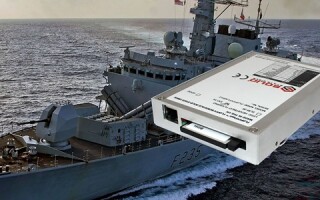Overcoming spectrum-management tech challenges
StoryOctober 08, 2024

For the U.S. military and its allies, domination of the electromagnetic spectrum will be how future battles are won. Enabling this superiority will revolve around how well these forces manage spectrum-sharing and foster innovation in RF [radio frequency], signal-processing, and testing solutions.
Battlefields take many forms – land warfare with tanks and troops, air warfare with fighter jets and bombers, space warfare with missiles, sea battles with submarines and ship-to-ship battles, even on the internet with cyber warriors. But perhaps the most critical field of battle for the U.S. today is the electromagnetic (EM) spectrum.
Success for the U.S and its allies in those more traditional domains will be based on how well they manage the spectrum and to what extent they can leverage technology to stay ahead of complex adversarial threats.
“We are seeing an increased push for integrators to build systems that can operate in highly dense and dynamic EM environments against threats that are known and unknown,” says Haydn Nelson, Business Development Manager – Radar, EW, EOIR, and SDR Solutions at NI, Emerson’s Test & Measurement Business (Austin, Texas). “The problem is one of the unknown threats and changing environments: Will a system operate in a specific dense environment, urban vs naval engagement? And do we need to reprogram the system to adapt to new threats?”
Overcoming electromagnetic spectrum management challenges isn’t just an electronic warfare (EW) problem.
“[It] will impact any system that uses spectrum, whether for communications, spectrum analysis, signals intelligence/EW, particularly systems that use or monitor any bands that proceed with spectrum-sharing,” says Manuel Uhm, Director, Silicon Marketing, AMD (San Jose, California) and Chair of the Board of Directors, Wireless Innovation Forum (WInnForum – Beaverton, Oregon). “Increased usage also results in increased noise which can pose technical challenges for comms or monitoring.”
Complex adversarial threats are also driving requirements and innovation. “Current threats such as low probability of intercept (POI), noise radars, and wideband frequency-agile emitters are pushing the boundaries of what is possible in the design of monitoring receivers and antenna technologies,” says Tim Fountain, Global Market Segment Manager, EMSO, Radar & EW, Aerospace & Defense Market Segment, Rohde & Schwarz France (Meudon, France). “In addition, the desire to stand off from in-theatre threats and control your own spectral footprint are driving the need for low-size, weight, power, and cost (SWaP-C) solutions that can be networked and automated.”
In the U.S., the wider government – and not just the Department of Defense (DoD) – is emphasizing a spectrum strategy.
“There is a lot going on in the world of spectrum management these days starting with the NTIA’s U.S. National Spectrum Strategy which broadly outlined four key pillars to ensure U.S. leadership in maintaining a spectrum pipeline and spectrum innovation,” Uhm says. [This strategy] will drive a number of initiatives from spectrum studies, multistakeholder groups, dynamic spectrum access [research and development], and workforce development.”
According to the NTIA strategy, those four pillars are:
- Pillar One: A Spectrum Pipeline to Ensure U.S. Leadership in Advanced and Emerging Technologies
- Pillar Two: Collaborative Long-Term Planning to Support the Nation’s Evolving Spectrum Needs
- Pillar Three: Unprecedented Spectrum Innovation, Access, and Management through Technology Development
- Pillar Four: Expanded Spectrum Expertise and Elevated National Awareness:
To read more on the NTIA strategy, visit https://www.ntia.gov/sites/default/files/publications/national_spectrum_strategy_final.pdf.
Uhm’s organization, the WInnForum, focuses heavily on spectrum-sharing as the standards bearer for CBRS (Citizen’s Broadband Radio Service), the first deployment of spectrum-sharing technology.
“We have been actively driving the development of AFC [Automated Frequency Coordination] frameworks and systems to enable spectrum-sharing in the 6 GHz band,” Uhm says. “Both scenarios required WInnForum to bring together multiple disparate stakeholder communities from the commercial and defense industries,” Uhm says. “In addition, we have now launched a Highly Dynamic Spectrum Sharing (HDSS) task group that has begun investigations into sharing in other bands such as the 3.1 GHz and 7/8 GHz bands. Naturally, each band comes with its own set of challenges, reinforcing the need to bring together all the impacted stakeholders.”
Sharing the spectrum
The spectrum is not the sole purview of the military. Many entities in the commercial and civilian government world make use of it, so proper sharing of the spectrum is critical.
“WInnForum has proven that different technology approaches can be used successfully to manage shared spectrum,” Uhm says. “This was proven first with CBRS’s Environmental Sensing Capability, which uses a network of sensors across the U.S. coastline to identify when incumbent Navy radars are active and, based on our approved propagation model, shut down or relocate in spectrum any CBRS devices (CBSDs) that have the potential to interfere with those radars. It was then proven again with 6 GHz’s Automated Frequency Coordination system, which depends on incumbent users informing where the spectrum will be in use that could cause interference.”
Each player using the spectrum has different goals and user methods, much like nations have different interests, but they need to find a way to coexist.
“The key is that different spectrum bands have different stakeholders with different use cases, so flexibility is critical,” Uhm explains. “For example, the 3.1 GHz band faces far more challenging shared-spectrum scenarios given that it needs to support incumbent airborne systems that are on the move (as well as shipborne and ground-based systems), which introduces new challenges beyond CBRS and 6 GHz. So new technologies and approaches will be required to support spectrum-sharing without interference to incumbent DoD users. It’s worth noting that those users would prefer sharing the band with commercial users rather than relocate to a different band, which would be very costly and take a long time.”
Technology backbone
Sharing the spectrum while enabling the military to pursue dominance will in the end be enabled by technology innovation, not by policy. Some of that technology already exists: “The reality is that the hardware technology to enable spectrum sharing has been available for quite some time,” Uhm says. “The regulatory environment and policies were more of a gating issue and then the system software needs to be developed to enable spectrum-sharing systems.”
The technology backbone of spectrum management dwells in the realm of RF and microwave technology and in the processing power of commercial processors and FPGAs [field-programmable gate arrays].
“All of these systems and solutions for spectrum-sharing and management rely heavily on embedded processors and RF solutions,” Uhm says. “Some rely on discrete analog components coupled with embedded processors such as FPGAs, CPUs and GPUs, but some also benefit from the smaller SWaP [size, weight, and power] of a single-chip analog and digital processor, such as the AMD Zynq Ultrascale RFSoC.”
System designers are also leveraging higher-sampling-rate ADCs [analog-to-digital converters], with direct conversion for some bands and integrated FPGA/DSP [digital signal processor], for example RFSoC [RF system-on-chip], Fountain notes. “Also GaN [gallium nitride]-based power amplifiers are enabling low-SWaP systems.” (Figure 1.)

[Figure 1 ǀ The Rohde & Schwarz CEPTOR aggregates key capabilities into one cohesive software platform. It provides electronic warfare specialists, signals-intelligence analysts, and spectrum managers both online and offline operational capabilities to help them understand and characterize the electromagnetic spectrum. Image courtesy Rohde & Schwarz.]
“The need to do digital streaming at high data rates is pushing the boundaries,” Fountain continues. “It’s now possible to completely saturate a PCIe bus with high-speed ADCs and DACs [digital-to-analog converters].”
To solve the riddles of the spectrum, RF solutions cannot be one-trick ponies; they must be able to handle different tasks for different applications in the spectrum.
“Many [electromagnetic] systems are being designed to be multifunction, adaptable, and affordable,” Nelson says. Being multifunction means a system can operate as an electronic support asset and then perhaps as a communication system or a sensor.
“Being adaptable allows for new capability to be re-programmed to meet mission requirements after the system is delivered,” he continues. “Systems that are adaptable on short mission timelines are quite disruptive to the way systems were used and designed in the past – gone are the days of boxed/fixed solutions.”
MOSA and the electromagnetic spectrum
For faster deployments of spectrum solutions that leverage commercial processing innovations, open architecture designs will be critical. “The solution comes down to two words: modularity, and easy reprogrammability,” Nelson says. “There are many standardization initiatives such as the U.S. Department of Defense modular open systems approach (MOSA) being proposed to solve the need for affordability and adaptability. “The notion that a system can be reprogrammed, or a module swapped to bring new capability, is obviously attractive and disruptive,” he adds.
Adding new capability at the expense of cost, however, can be a roadblock in today’s DoD. “RF and DSP technologies are constantly evolving and it’s always fun to talk about the latest RF and DSP device or capability,” Nelson says. “However, not every system requires the most advanced RF and DSP technology.
The highest performance comes at a cost, he notes. “The solution is using the right tool for the job in a modular cost-effective way. The test-and-measurement industry underwent a similar move from boxes to modules decades ago.”
The MOSA strategy enables military systems to keep pace with commercial technology innovation while smartly integrating tech for battlefield environments.
“Military embedded systems have many unique challenges such as ruggedization and harsh environmental constraints,” Nelson says. “Modularity allows engineers to scale the solution in a standard way to meet requirements, control cost, and rapidly adapt.”
Testing spectrum solutions
Spectrum-management solutions rely heavily on accurate test-and-measurement systems to verify each component in a system.
“If systems are to meet this vision of being rapidly adaptable, test is a critical part of that process,” Nelson says.
Testing is not just at the system level but also down to the level of testing of individual components and boards.
“Test is broken down into component test, such as a mixer or amplifier, board-level functional test, and finally system-level verification,” Fountain explains. “Each level of the test has different requirements, from parametric verification through functional test to system interoperability and compliance test.”
NI’s Nelson says that he goes back his two questions above when speaking to testing spectrum solutions – on environment and the unknown threat – “Will a system operate in a specific dense environment? And do we need to reprogram the system to adapt to new threats?
“Many labs and integrators are looking to solve two things as it relates to test,” Nelson explains. “How I can deliver a system that provides validated capability today and adapt with validated capability against unknown threats in the future.”
Test systems must also be future-oriented and modular in nature. (Figure 2.) “The challenge of test is designing for the future adaptation: If the delivery embedded system is reprogrammable on the time scale of days, the test gear must similarly be adaptable,” Nelson notes. “It’s more than just test scenarios; as electromagnetic environments get denser, we need to test against those evolving scenarios. A solution that adds another box per emitter can get out of hand in terms of cost very quick.”

[Figure 2 ǀ The PXIe-5842 from NI (now part of Emerson) is a vector signal transceiver (VS), which combines a vector signal generator and vector signal analyzer into a single four-slot PXI Express instrument. Image courtesy NI, Emerson’s Test & Measurement Business.]








